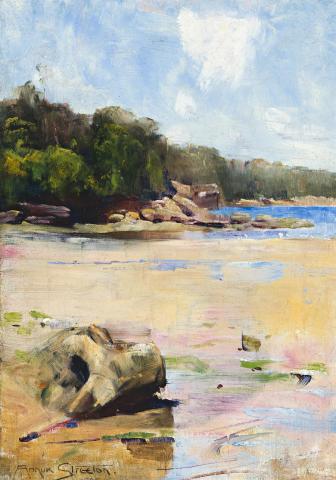SIRIUS COVE, 1895
ARTHUR STREETON
oil on canvas
35.0 x 25.0 cm
signed and dated lower left: Arthur Streeton / 1895
Joseph Brown Gallery, Melbourne
Private collection, Melbourne
Spring Exhibition 1980, Joseph Brown Gallery, Melbourne, 1 – 10 September 1980, cat. 58 (illus. in exhibition catalogue)
Arthur Streeton and the Australian Coast, Mornington Peninsula Regional Gallery, Mornington, 11 December 2004 – 6 March 2005 (label attached verso)
In the history of Australian Impressionism three names stand out as places of special importance - Box Hill and Heidelberg in Melbourne, and Sirius Cove on Sydney Harbour. It was here that Tom Roberts and Arthur Streeton variously camped and painted their early landscapes in the lively, plein air manner of the time. They were halcyon times, recollected in idyllic terms. It was late in the nineteenth century, often referred to as a golden age in Australian art. The celebration of a century of achievement in 1888 aroused a period of nationalistic pride expressed in the prose and poetry of Henry Lawson and Banjo Patterson, and the grand subject pictures of toiling pioneers and bold horsemen by McCubbin and Roberts. Streeton found his inspiration in the unique Australian landscape, exploring the gentle lyricism of twilight moments, or the awe-inspiring grandeur of high noon. His panoramic Hawkesbury landscapes of the mid-nineties captured, like none before him, the brilliant transparency of the Australian light. A few years later Dorothy Mackellar gave words to Streeton's vision in her iconic poem 'My Country' - "I love a sunburnt country, A land of sweeping plains".
Streeton's Sirius Cove 1895 was painted in the same year that Banjo Patterson penned the lyrics for 'Waltzing Matilda'. Some of his best paintings belong to this period, especially those inspired by Sirius Cove painted on long, narrow panels, radical in compositional devices. Perhaps the finest is Sirius Cove 1895 in the collection of the National Gallery of Australia, Canberra, rivaled by Sydney Harbour 1895 in The Joseph Brown Collection of the National Gallery of Victoria. Both are striking in format and placement of pictorial elements. This same adventurous approach is seen in our Sirius Cove 1895. Although painted on canvas of a more conventional shape, Streeton's focus on the large foreground rock and pools of water is dramatic and novel. Not only does it enable him to introduce blues and greens into the otherwise yellow-brown sandy shore, but it also brings the foreground and background into sharp contrast. The intended spatial ambiguity between, with its playful handling of perspective, is characteristic. The immediacy of Streeton's identification with the scene, is strongly felt. He shares this with the viewer through the spontaneity of his technique, vivacious brush strokes conveying the sparkling atmosphere enveloping the scene. Suited to the portrayal of a quiet, almost intimate corner of the glorious harbour through its smallness of size, Sirius Cove, nevertheless, is not without its touches of grandeur. Moreover, the painting overflows with the fullness of youthful exuberance, evoking engagement with the land of golden sunlight and its glorious future.
DAVID THOMAS
